Central heating inhibitor is the heating equivalent of a stage director. It works behind the scenes and plays a very important part in keeping everything running smoothly. But most people aren’t really sure what inhibitor is, what it does or the disasters it can prevent.
In fact, it is so crucial to a well performing heating system that most boiler manufacturers state that your warranty could be invalid if your central heating doesn’t have the correct inhibitor levels.
So what is radiator inhibitor and why is it so important?
What Is Central Heating Inhibitor?Central heating inhibitor is a chemical liquid used to protect your central heating system and keep it working efficiently to prolong its lifespan.
Inhibitor is made up of a mixture of potassium tetraborate tetrahydrate, disodium molybdate, sodium nitrate and 2,2′,2”-nitrilotriethanol.
It is usually clear or a pale yellow color and must be stored in its original container in a cool well-ventilated place away from direct sunlight.
Over time, radiator sludge builds up in your central heating system from an unavoidable mixture of rust, dirt and scale. This thick gloop sits at the bottom of your pipes and radiators which stops the water running through your system properly and your radiators heating up efficiently.
That’s where the inhibitor comes in.
The chemicals in the inhibitor work together and the chemical reaction breaks down the sludge in your central heating system and protects it from building up again.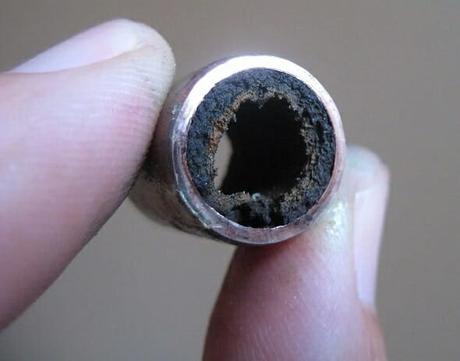
Not only does radiator inhibitor ensure that your radiators and pipes are in good shape, but it is a crucial part of protecting your heating system and could also save you a load of maintenance costs on repairs for issues that inhibitor could have prevented.
Plus, as we mentioned earlier, your boiler warranty may even be void if you don’t use inhibitor because it is an essential part of a fully functioning central heating system.
So let’s get on with how to add it to your system.
When adding inhibitor to the system you should use a full bottle to make sure there is enough to pump around the system. This is usually about a liter but it depends on the concentration of the inhibitor and how many radiators you have. We would always advise that you check the instructions from the manufacturer on the back of the inhibitor bottle to make sure you are using just the right amount.
Can You Add Too Much Inhibitor?The simple answer is no. You can never add too much inhibitor to your central heating system and dosing it up cannot cause any damage. Adding more inhibitor is only a good thing for your system as it will provide even more protection.
Here’s How To Add Inhibitor To Your Central Heating SystemAdding inhibitor to your central heating system is a pretty easy task that you will be able to do yourself. So don’t panic if you haven’t done it before! But there are a couple of different ways to do it depending on which type of heating system you have.
Most people in the UK have a combi boiler system. So we will take you through that method first before looking at the other ways to do it.
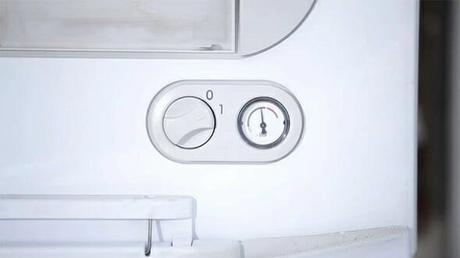
Time needed: 1 hour.
How To Add Inhibitor To A Combi Boiler System
- Turn the heating off.
Make sure you let the radiators cool down completely before moving on to step 2.
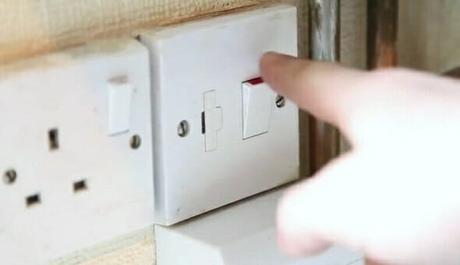
- Drain the whole system.
Take a look at our full guide on how to drain your heating system.
- Shut off the drain valve.
The drain off valve may be located on the lowest part of the plumbing pipes, or on an outside wall.
- Unscrew the radiator bleed plug.
Use a spanner to remove the unscrew the bleed plug and remove it.
- Attach the inhibitor dosing adaptor.
Some inhibitor brands provide a dosing adaptor with the bottle to attach to the radiator bleed plug. If you don’t have an adaptor you can use a funnel and flexible tube.
- Pour the inhibitor in.
Slowly pour the inhibitor into the dosing adaptor or funnel (you only need to pour the inhibitor into one radiator).
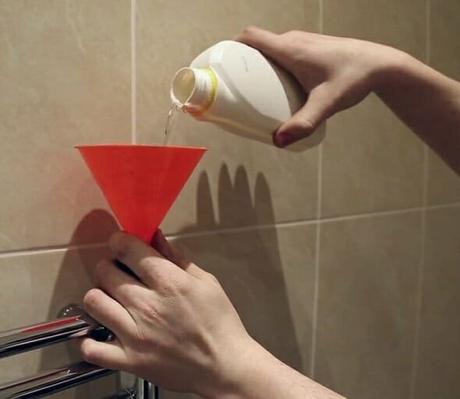
- Remove the adaptor or funnel and tighten the bleed plug back on with a spanner.
Be careful not to overtighten the valve as you could damage the ‘O’ ring.
- Turn the radiator valves back on.
To open the valves, turn them anti-clockwise.
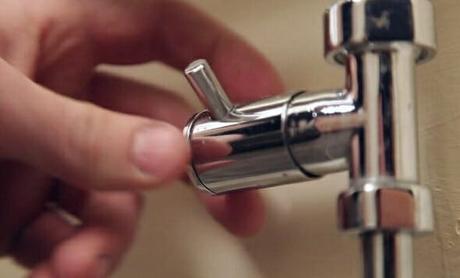
- Check the boiler pressure and top it up if needed.
Standard boiler pressure is around 1.5 BAR, but check the manufacturing guidelines if you’re unsure.

- Bleed your radiators.
It’s a good idea to bleed your radiators at this point too.
How To Add Inhibitor To A Sealed System
If you have a sealed heating system with an expansion vessel, add the inhibitor to the system via the filling loop instead of directly into the radiator.
You may need to drain some water from the system before you add the inhibitor since water cannot be displaced in a sealed system to allow enough space for the extra liquid.
How To Add Inhibitor To An Open Vented System
If you have an open vented system with a large water tank and a small expansion tank, you need to add the inhibitor to the smaller tank.
Before you do this, make sure you have turned the water off at the mains or by using the valve on the tank. You must also check that the tank is nice and clean and corrosion free. If it looks like it needs a good clean, make sure to do so before you start adding inhibitor.
How Often Should Central Heating Inhibitor Be Changed?
Over time, central heating inhibitor dilutes which means it can no longer do its job properly and provide enough protection for your system against sludge, limescale and rust.
Inhibitor usually lasts around a year and your heating engineer should test the system and add the inhibitor during the annual service.
If your radiators are taking a long time to heat up and you think you need to add inhibitor to your system, you can also test the system yourself with a simple central heating inhibitor test kit
These home kits are easy to use and great for giving you an accurate measurement of the concentration of inhibitor in your system using a sample of water from your radiator.
You should also add more inhibitor to your system if you have recently drained the system to flush a radiator for example.
Or, if your system recently had a leak and you had to regularly top up your boiler pressure, you will need to add more inhibitor because topping up the pressure dilutes the chemicals and reduces the protection.
What Is The Best Central Heating Inhibitor?
There are several leading brands that offer high quality inhibitors such as Sentinel X100, MagnaClean MC1 and Fernox F1.
Fernox F1 has been around the longest, but Sentinel is also hugely popular. Your heating engineer may have a preference, but they will all get the job done.
If you’re unsure which inhibitor to use, have a look into which one is best for your specific system requirements.
At this point, you probably agree that central heating inhibitor is pretty important. Crucial, in fact, for a healthy heating system. But there are a couple of other important things you should do for maximum system protection and boiler longevity.
3 Ways To Protect Your Central Heating System
Flush Your Radiators
Think about it, if you have been busy adding inhibitor to break down the sludge and dirt in your system, you need a way to get it out!
Fushing your radiators is the best way to do this, or even better, book a power flush with your heating engineer to really get all the gunk out.
Install A Magnetic Boiler Filter
Magnetic filters are great for protecting your boiler as they catch all the bits of metal and broken down sludge before making its way to the boiler to do any damage.
These clever little filters must be removed and cleaned once a year during your annual boiler service, so they work hard and require very little maintenance.
Add A Scale Reducer
As good as they are, magnetic filters are not able to remove limescale. That’s where your scale reducer comes in!
Limescale can do real damage to your system and cause expensive repair bills. So it’s a good idea to get a scale reducer to save you money in the long run.
Quick Recap
Central heating inhibitor is important because it:
- Breaks down radiator sludge
- Keeps radiators working efficiently
- Prevents boiler breakdowns
- Prolongs boiler lifespan
- Save you money on maintenance costs & repairs
- Validates boiler warranty
We hope you have found this guide useful and that you are finally convinced that inhibitor is a crucial component in your central heating system.
Like with any other central heating job, if you don’t feel confident getting it done yourself, always contact a Gas Safe Registered engineer.
If you have any further questions, feel free to drop us a comment below.

